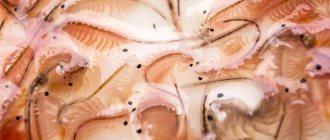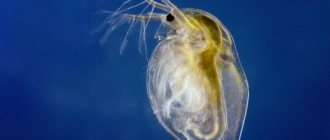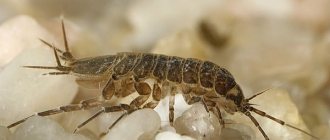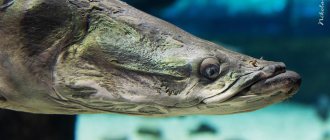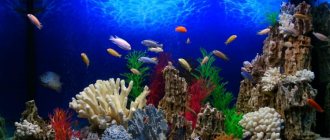Daphnia is a fairly large genus of cladocerans, with more than 55 species in the fauna. Due to their growth (females - up to 5 mm, males - up to 3), these crustaceans received the second name “water flea”.
Daphnia is used as live food for fish. And if earlier they went to rivers and lakes to catch them, now this species can be bred at home.
Description and variety of water fleas
Daphnia is a crustacean planktonic creature with a rounded body and fairly small size. This species grows up to 6 mm, and the female is always larger than the male. Their chitin shell almost completely envelops the body. On their head they have an eye and 2 unique antennas, thanks to which the crustaceans can make sharp leaps in the water. Under the eye of Daphnia there is a kind of beak, under which there are olfactory bristles.
In nature, the number of females is twice the number of males.
The genus Daphnia has more than 100 species of crustaceans, which are divided into 10 different families.
| Name of crustaceans | Description |
| Magna (Daphnia magna Straus) | The largest species. Females grow up to 6 mm, males - up to 2. They give birth to offspring every 14 days, producing about 90 eggs at a time. Their life expectancy is from 15 to 21 weeks. |
| Pulex (Daphnia pulex De Geer) | They grow up to 5 mm. They lay eggs every 5 days, producing about 25 eggs at a time. They live up to 2 months. |
| Longispina (Daphnia longispina Muller) | There are up to 4 mm. They do not live in aquariums. |
| Livebearer (Moina macrocopa, M. rectirostris) | Females reach up to 2 mm in length, males - up to 1 mm. They lay eggs every 2 days, with about 55 eggs in one litter. Lives on average 3 weeks. |
| Bosmina | The smallest species of daphnia, its characteristic feature is its bright black color. They do not take root in the home environment. |
The table contains the most common and studied species, which are often used as live food for aquarium fish.
Life cycle
The ability to reproduce does not require fertilization. Females have a brood chamber. It is protected by the edge of the shell. Favorable conditions promote the laying of 50 to 100 unfertilized eggs. Females develop in the cavities. Then the females emerge from the cavity.
Shedding
The females begin to molt. A few days later, the reproduction process is repeated with the help of older individuals. One female can have up to 25 offspring during her life. Because of this, the color of the reservoir becomes reddish.
Men's participation
In the fall, males begin to participate in the process. The fertilized membrane is very dense. It is able to withstand severe frosts and drying out of reservoirs.
The appearance of offspring
With the onset of spring, reproduction is repeated thanks to females. New populations have different body shapes. The lifespan of large daphnia is from 4 to 5 months. For other representatives it can take up to 3 weeks.
How to keep daphnia at home
Daphnia is quite unpretentious in maintenance, it can be grown in any container. A transparent tank is best suited for this, so that monitoring their development is easier. The water must be allowed to stand for at least a day; this is required to remove chlorine from the liquid, which can be harmful to crustaceans. Water hardness does not play a big role, but the temperature regime should be observed. The temperature should not exceed 21 degrees, this is required for faster reproduction.
It is necessary to replace the water every 3 days with water at the same temperature, but not more than 25% of the volume. Additionally, the bottom should be cleaned to get rid of debris that could spoil the water.
It is also recommended to place snails in the aquarium, which are capable of cleaning the tank and removing leftover food. It would also be useful to install aeration, which will ensure the freshness of the water.
What and how to feed daphnia
There is no specialized food for daphnia and no restrictions on any ingredient. However, you should not use products for feeding that can cause rot or decomposition in water. Such products include:
- banana peel;
- pieces of bacon or trout;
- pieces of meat.
The optimal food for crustaceans is presented in the table.
| Name of food | Where to get? |
| Powdered algae | Specialty stores |
| Dry food for shrimp larvae | Specialty stores |
| Dry yeast with the addition of flour from a 1:1 ratio | Any grocery store |
| Boiled egg yolk | Home cooking |
| Pieces of apples or cucumber (use as top dressing, remove any leftovers) | Home cooking |
Do not forget that you should not overfeed daphnia. The food must be poured into the aquarium and mixed in water. Keep track of how long it takes for the water to clear completely. If the water becomes clear within a few hours, it means there was little food. But if the water remains cloudy the next day, there is too much food.
It is recommended to feed crustaceans 1-2 times a day.
Where to get daphnia for breeding
Purchasing daphnia for breeding is not difficult, but each method has its own risks. There are the following methods for obtaining crustaceans:
- Purchase in specialized stores. This is one of the safest ways to obtain healthy cladocerans, in which the risk of obtaining diseased daphnia or various bacteria is minimized. Moreover, there you can buy everything you need to maintain them and get advice.
- Order online. There is a risk of getting dead daphnia or not getting any at all, so choose your store carefully.
- Buy from an experienced aquarist. If you come across an honest and truly experienced person, then the losses may be minimal, as in the first case.
- Self-catching. In the summer, daphnia are found in large quantities in almost all reservoirs. However, there is a risk of catching various bacteria along with crustaceans, which can harm not only the crustaceans, but also your fish in the future.
If you want to start breeding daphnia, it is better to purchase them from trusted sources; this can not only reduce costs, but also create a favorable environment in the aquariums.
Habitat
Daphnia are usually found in all standing bodies of water, from a pond to a deep lake. These crustaceans are even found in Antarctica. The main condition for the habitat of daphnia is standing freshwater with a minimum amount of soil particles.
When daphnia enter groundwater, they filter the soil and gradually accumulate algae in their intestines, clogging it. These crustaceans do not like polluted water bodies, so they can be used to judge the cleanliness of a river, lake or pond.
They live for about 22 days
In reservoirs where daphnia live, most of their life passes in the water column. Some species can live at the bottom, eating dead parts of plant food and the remains of invertebrate animals. They can also be found in other places - puddles, holes with water. Crustaceans react very sensitively to lighting, and when it is too bright, they go deeper. Large daphnia lives for 110−150 days. The life cycle of other species is much shorter and can be up to 22 days.
How to breed daphnia at home
Any container other than plastic and stainless steel is suitable for propagating daphnia at home, since such containers can release toxic substances when interacting with water. For successful breeding, the following conditions must be met:
- Maintaining a temperature of 18 to 22 degrees. Too high a temperature can slow down the reproduction process.
- Fresh water. This type of plankton is a freshwater species, and high salinity can kill daphnia.
- Low acidity and no ammonia. The presence of ammonia is detrimental not only to daphnia, but also to all living organisms. The optimal pH value is 6-10.
- Compliance with the aeration regime. Too large and intense air bubbles can kill the inhabitants, and a lack of oxygen can provoke the development of bacteria and parasites in the water and on its surface.
It is also recommended to put some rotted leaves on the bottom and plant algae, the shoots of which the crustaceans will feed on. Yeast can also serve as an additional feed. However, keep a close eye on the color of the water. A bright brown color may indicate bacterial growth. The number of offspring hatched, as well as the frequency of hatching, depends on the type of daphnia and care.
Aeration
When talking about how to breed daphnia, novice aquarists may ask: is aeration necessary when growing and cultivating crayfish? Experienced experts say that it is desirable, especially when growing Daphnia moina. It enriches the water with oxygen, promotes the development of phytoplankton and prevents the formation of a film on the surface of the water. The main thing is that aeration should be of medium intensity, since a strong air flow will disturb them, and a flow with small bubbles will accumulate under the shell of the crayfish and lift them to the surface.
How to make fish food from daphnia
It is necessary to prepare dry food on a bright sunny day, armed with a net, a drying surface and gauze. You must follow this algorithm:
- We catch the daphnia with a net into a container, without squeezing it out, but simply let the water drain.
- When the container is half full, you need to dilute the remaining half with water.
- It is necessary to catch plankton from the container with a mug, constantly scooping up water from the bottom up with quick movements. This is done to prevent the crustaceans from settling to the bottom.
- The water should be poured onto a pre-positioned frame covered with a layer of gauze.
- Drying should be done against the sun. The rays must hit perpendicularly.
With proper and uniform drying, this process is carried out within 2-3 hours.
Daphnia must be stored in a cardboard or wooden box. The shelf life of such food is from 6 months to 1 year.
How to feed your fish with daphnia
The main rule of feeding is not to overdo it with the amount of food, since daphnia can decompose very quickly, thereby polluting the water and allowing bacteria to develop, which can lead to fish diseases. You should also follow these tips:
- always grind the food into powder before use - since large particles do not have time to swell in water, and this can cause the food to swell in the fish’s belly;
- Before use, pour boiling water over the food and let it brew, then rinse by settling;
- It is recommended to mix with gammarus to improve the nutritional value of the feed.
Dry daphnia can be used as the main food and for bait.
Thus, daphnia is an ideal live and dry food for fish, which is easy to reproduce and also does not require special care and maintenance costs. The nutritional benefits of these crustaceans will keep your fish healthier and happier.
Danger to humans
Because of their association with insects, many people believe that Water Fleas bite. But they do not have the corresponding organs, which means that such bites are excluded. Daphnia can cause harm only by causing an allergic reaction in people predisposed to it. As they absorb food, they also accumulate dangerous pollen, the concentration of which increases in dried organisms.
According to statistics, crustaceans cause allergies in almost every fourth person. It manifests itself in the following symptoms:
- itchy skin rashes, like hives;
- dryness and congestion of the nasal sinuses, runny nose;
- frequent involuntary sneezing;
- allergic conjunctivitis with tearing;
- difficulty breathing due to bronchospasm;
- bronchial asthma.
To diagnose the condition, doctors analyze a skin test. In case of positive results, antihistamines are prescribed and contact with Daphnia is avoided.
